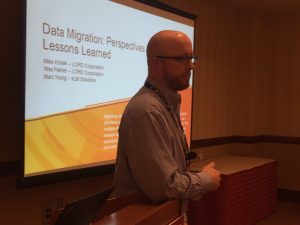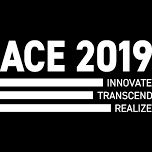We just got back from the Aras ACE 2019 conference Innovate, Transcend, Realize in Phoenix. PLM conferences are always so exciting because we get to network with colleagues, see old friends and learn some cool stuff.
We enjoyed hearing from the CEO and founder of Aras, Peter Schroer with his take on digital transformation and the digital thread. He opened the conference with these words: “Digital transformation used to be called PLM.” The customer spotlight from Microsoft suggested that “the PLM journey is never done.” The General Motors customer spotlight focused on change management, agile deployment and rapid iterative processes.
Our Presentation: Data Migration Perspectives and Lessons Learned
I joined our customer LORD Corporation for our Aras ACE presentation on Data Migration Perspectives and Lessons Learned. The discussion and question and answer period brought up two frequently asked questions.
When conducting a data clean-up before a data migration project, is it a manual process or can it be automated?
The answer is: a little of both.
Some aspects of the data clean-up can be automated. For instance, we automated a rule that for any revision value that is not a valid revision we set the revision to a dash. However, some aspects of the data clean-up cannot be automated and require manual input. For instance, we might encounter objects that have the same part number but are represented by different files. In this case, we need someone to look at the “duplicate” file and determine which one is valid and how to set the part numbers for each object.
Another attendee asked about how long migrations usually take. This is a common question.
The answer is: It really depends on the scope of the migration. We have worked on migrations that have taken days to a year to multiple years. For the data migration we conducted with LORD Corporation, we spent about 100 man-hours of work, with LORD corporation also putting in a similar amount of time. The total calendar time for the migration occurred over 3 months.
Contact me if you would like more information about our presentation on data migration. It will also be posted on the Aras.com website soon.
Aras Future Strategy
The long-term direction and strategy for the future for Aras is all about the customer experience and the digital thread (this was the main theme throughout Aras ACE). It comes down to connecting all operations and data, from initial requirements to system engineering to product design, MCAD, ECAD software, etc., plus supplier involvement and interaction, testing and quality, manufacturing and support in the field. The digital thread is an iterative process which may drive new and updated requirements to continue the design process.
The key point is that different users may need access to different threads of connected data throughout the production lifecycle. For example, users will be able to work on a new innovation, provide information to regulatory agencies or quickly diagnosis and fix a safety issue. With connected data, users can access the different digital threads easily and as needed.
Aras will release its 12.0 version soon. The main new functionality is designed to improve the user experience. Aras has made the following improvements to the user interface:
- The Login screen now runs with a Client browser tab; there is a configurable log and background image; and supports a new authentication server.
- Once users log in, they will see an updated Header Bar, a Navigation Button, Full Text Search dialog, Notification button and User Menus to open user-specific top-level commands and actions.
- All main content is now displayed as separate tabs, including: Searches, My InBasket, Dashboards, etc.
- The updated Search Toolbar drives more user-friendly and efficient searches, with Search Toolbar highlights of the most common commands, all paging commands displayed together in the footer, and secondary search commands grouped together. Users can access the drop-down selector for favorite searches.
- The interface includes new simplified Item editing and Lock and Unlock has been changed to edit and save. It offers improved usability for adding items to relationships and improved logic to prevent users form leaving an Item in an editable state.
- Accordion Item View allows for a more convenient way to scroll through Item information. The different sections of the Item view can now be collapsed and expanded.
I attended these insightful break-out sessions at Aras ACE.
Requirement Engineering
This session described how to manage your requirements, including breaking them down into multidisciplinary requirement structures. It discussed functionality on how requirements can be captured – from any data such as files, emails, scanned images, URL links, pictures, videos (even from YouTube), as well as existing PLM items such as parts, materials, drawings and models. Requirements can be linked with various engineering data that will satisfy the requirements so that the requirements can be tracked and verified through the product lifecycle with reports for end users.
Access Control Mechanisms – Aras Security Options
This break-out session focused on three different security models in Aras.
- Standard security where you give group or identity permissions to users controlling what they can see, edit, view, etc.
- MAC security is more of a deny security where administrators can explicitly deny users the ability to see data. This is used for meeting military security requirements like ITAR. For instance, you can set up rules to control access by IP address to deny users who are outside of the U.S. access to certain data.
- DAC security is what I liken to project-level security. For instance, you can set query builder objects (new technology in Aras) to allow security based on data linked to projects. This will allow administrators to set specific users up in a project with set securities or roles, e.g., project engineers. Administrators can then set up the same users in a different project with different security, i.e. simple project viewers.
Process Planning with Aras MPP
This presentation discussed various features for the MPP solution in Aras.
- Creation and version control of plant-specific process plans that can include detailing operations, steps, parts consumed, resources utilized, skills, documents referenced, etc.
- Creation and version control of MBOM derived from EBOM using drag-and-drop editing concurrent process plans and MBOM creation.
- Automatic EBOM/MBOM reconciliation. Some of the benefits are to bridge the gap between engineering and manufacturing BOM structures. This eliminates time-consuming manual processes and costly EBOM/MBOM conflicts, such as overutilized and underutilized part quantities.
- Improved efficiency by synchronizing process plans, MBOMs and work instructions.
- Creating the digital thread with as-designed to as-planned traceability.
- Associate engineering data, i.e., an EBOM to a process Plan(s) and build an MBOM, can associate various objects like Tools, Tasks, etc., that give the instructions and plan on how to move to manufacturing with the BOM. The project plan can then be output in various reports as needed.
We had a fun night out at the beautiful Desert Botanical Gardens in Scottsdale.
Aras ACE 2020 will be in Boston on March 16-19, 2020. I hope to see you there.
Contact xLM Solutions for help with your Aras projects.


